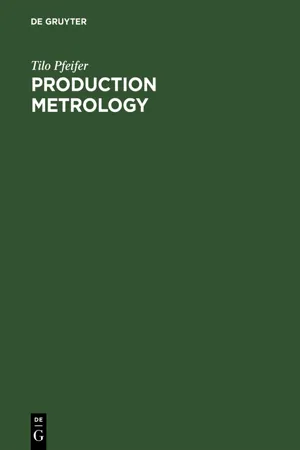
- 421 pages
- English
- PDF
- Available on iOS & Android
Production Metrology
About This Book
This work presents the systematics of production metrology starting from the inspection planning, across the recording of the inspected data up to the evaluation of this data. On the one hand, the reader will be supplied with basic knowledge for the understanding of the presented procedures and their practical use. On the other hand, he will also learn about the importance of production metrology for quality control in production processes. It is not only an indispensable reference book for the daily work of the engineer, but also a invaluable and easy to read text book for students. As a supplement for the studies, the book gives a fast overlook to the basics of production metrology and, at the same time, shows how this knowledge is put into practice.
Frequently asked questions
Information
Table of contents
- 1 Introduction
- 1.1 Functions and Objectives of Production Metrology
- 1.2 Historical Development of Production Metrology
- 1.3 Production Metrology as a Component of Quality Management
- 1.4 Overview of Production Metrology
- 2 Fundamentals of Production Metrology
- 2.1 Basic Concepts
- 2.1.1 Introduction to the Sl-System of Units
- 2.1.2 Definitions
- 2.1.3 Measuring Methods
- 2.1.4 Measurement Strategies
- 2.2 Measure Embodiments
- 2.2.1 Gauge Blocks
- 2.2.2 Incremental Measure Embodiments
- 2.2.3 Absolute encoded measure embodiments
- 2.3 Measurement Uncertainty and Measurement Error
- 2.3.1 Definitions and Terms
- 2.3.2 Factors Influencing Measurement Error
- 2.3.3 Procedures for estimating measurement uncertainty
- 2.3.4 Measurement Uncertainty and Tolerance
- 2.4 Measurement rooms
- 2.5 Drawings specifications and tolerances
- 2.5.1 Dimensions, dimensional tolerances and fits
- 2.5.2 Tolerance of form and position
- 2.5.3 Tolerancing principles
- 2.5.4 Geometrical product specification and inspection (GPS)
- 3 Inspection Planning
- 3.1 Tasks of Inspection Planning
- 3.2 Procedure for Setting Up an Inspection Plan
- 3.2.1 Definition of the Inspection Plan Header
- 3.2.2 Selection of Inspection Characteristics
- 3.2.3 Determining Inspection Time
- 3.2.4 Determining Inspection Type
- 3.2.5 Determining the Inspection Extent
- 3.2.6 Selection of Inspection Site and Personnel
- 3.2.7 Selection of Inspection Equipment
- 3.2.8 Inspection Text and Documentation
- 3.3 Utilisation of Results
- 3.4 Possible fields of application
- 4 Test Data Acquisition
- 4.1 Shop floor Inspection Equipment
- 4.1.1 Callipers and Height Measuring Devices
- 4.1.2 Micrometers
- 4.1.3 Display Sensors with Mechanical Transmission
- 4.1.4 Angle Measuring Devices
- 4.2 Measuring Sensors
- 4.2.1 Potentiometer Sensors
- 4.2.2 Inductive Sensors
- 4.2.3 Capacitive Sensors
- 4.2.4 Pneumatic Sensors
- 4.2.5 Ultrasonic Measuring Methods
- 4.2.6 Measuring Sensors with an Incremental Material Measure
- 4.2.7 Sensors with Encoded Materia Measures
- 4.3 Optical and Optoelectronic Testing Equipment
- 4.3.1 Optical and Optoelectronic Elements
- 4.3.2 Camera Metrology
- 4.3.3 Laser Metrology
- 4.3.4 Optical Measuring Devices
- 4.4 Coordinate Measuring Technology
- 4.4.1 Fundamentals of Coordinate Measuring Technology
- 4.4.2 System Components and Designs of Coordinate Measuring Machines
- 4.4.3 Application of Coordinate Metrology
- 4.5 Form and Surface Testing Technology
- 4.5.1 Form Testing Technology
- 4.5.2 Surface Inspection Technology
- 4.6 Gauging Inspection
- 4.6.1 Taylor’s Principle
- 4.6.2 Types of Gauging Inspections
- 4.6.3 Norms for Gauging Inspection
- 4.6.4 Principle of Virtual Gauging
- 4.7 Integration of inspection devices into automated measuring applications
- 4.7.1 Electronic Handheld Measuring Devices at the Computer-Aided Measuring Station
- 4.7.2 Robot-Aided Measurement Devices
- 4.7.3 Multi-Point Measuring Devices
- 5 Test Data Evaluation
- 5.1 Fundamental Statistical Principles
- 5.1.1 Descriptive Statistics
- 5.1.2 Distributions
- 5.1.3 Inductive Statistics
- 5.2 Statistical Process Control
- 5.2.1 Random Sample Testing Schedules
- 5.2.2 Structure, Design and Application of Shewart-Quality Control Charts
- 5.2.3 Statistical Background
- 5.2.4 Practical use of the Control Chart Technique
- 5.2.5 Newer Types of Quality Control charts
- 5.2.6 Boundary Conditions for the Use of Control Charts
- 5.3 Capability of Production Processes
- 6 Management of Inspection Equipment
- 6.1 Inspection Equipment Monitoring
- 6.1.1 Traceability
- 6.1.2 Inspection Equipment-Specific Monitoring
- 6.1.3 Inspection Task-Specific Monitoring
- 6.1.4 Dynamic Inspection Equipment Monitoring
- 6.2 Inspection Equipment Planning and Provision
- 6.3 Inspection Equipment Management
- 7 Index